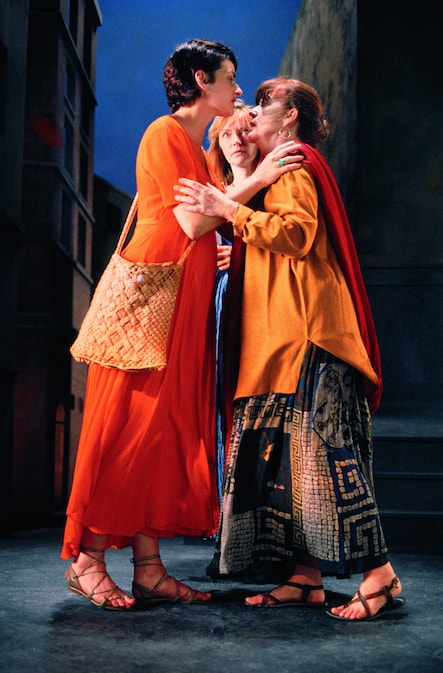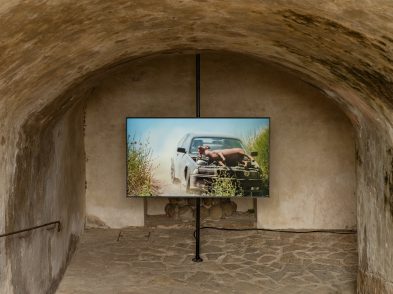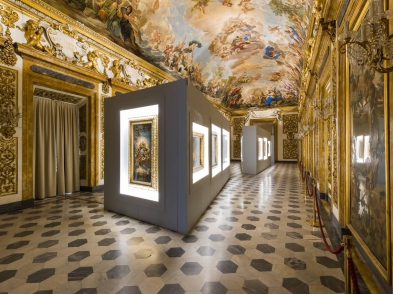Although Bill Viola’s installations employ innovative sophisticated video and computer equipment, the great themes he explores are ancient and universal. What’s more, during the past two decades, this internationally acclaimed American has established himself as one of the few contemporary artists to break through to mainstream audiences. While his electronic medium is cutting edge and his approach highly influenced by the processes of conceptual art, his imagery is often indebted to Renaissance masterpieces, such as those he first encountered 40 years ago in Florence. Palazzo Strozzi’s ambitious retrospective reunites Viola with his inspirations.
Bill Viola is a supreme maker of images. These images do not so much relate a narrative as immerse his audiences in bodily experiences. Figures projected on a monumental scale, often accompanied by resonant sounds like sudden rain, endure exposure to fire and water, display tranquillity and agitation and appear slowed into meditative dream states. Their actions and gestures are magnified into significance beyond the real.
In The Crossing (1996), water acquires an elemental force. A man walks in slow motion out of the blackness to eventually confront the viewer at over life-size. Water dripping from above soon becomes a torrent that overwhelms the figure, so that his profile disappears within its violent downward rush. On the reverse side of the screen, the same man appears again, approaching the viewer to be consumed this time by rising flames, the antithesis of water. Confronted in this way with astonishing occurrences simply composed, the viewer has no option but to look for meaning beyond any retelling of everyday events. Part violent destruction and part peaceful transcendence, The Crossing implies a spiritual dimension that is seldom satisfactorily conveyed in words.
Clearly at odds with the ubiquitous cynicism of our age, Viola’s work is informed by a set of spiritual values that has had a profound and continuing impact on his development. As he engages with the biggest themes of birth, death, individuality and transcendence, these values have shaped his distinctive visual language. The characteristically slow-moving figures in Martyrs (2014) are subjected to various elemental manifestations of earth, fire, air and water. The images mesmerise as if seeking to draw us out of the present moment and deposit us in a discrete, virtual space carved out of the gallery wall by the key property of video—its illusion of immediate realism. Beyond recognisable time, this imagined space allows us to forget for the duration that we are standing with others in a darkened public interior—a museum that might just as well be a church, library or train station.
Martyrs is a study of suffering and redemption. It is not an explicitly Christian work, but has its roots in both eastern and western traditions. For Viola’s inspirations represent an eclectic mix—Zen Buddhism, Christian mysticism, Islamic Sufi poetry, American free verse, optics and the mechanisms of perception—that generates rich and seductive effects. In terms of artistic experience, his work exists between the most elevating forms of painting in history and the temporal spectacle of cinema. Like Hollywood, Viola offers his audience psychically charged identification with the figures in cinematic tableaux that frequently recall the composition of frescoes by Giotto or openly quote Pontormo.

Bill Viola, The Greeting, 1995, 10’22”. Courtesy Bill Viola Studio
In The Greeting (1995) the shifting relationship between three women, dressed in richly coloured garments, is observed in a street, once more in extreme slow motion, as simultaneously spontaneous and disarmingly portentous. What is the spectator’s role? Fourth friend or voyeur? Meanings remain elusive but this encounter is indebted to Pontormo’s Visitation at Carmignano. It is for that reason that the astonishing masterwork has been included in this show. The exhibition then spreads into neighbouring sites, such as the Uffizi, Santa Maria Novella and the Museo dell’Opera del Duomo, to set up further encounters with history.
Viola does not restage these older images. Instead he demonstrates what happens when they are absorbed and transformed in the mind. For instance, although he sketched Masolino’s Pietà (1424), it took some time before it led him to make Emergence (2002) in which two figures pull a third from a cistern overflowing with water.
Viola does not specify the Biblical source that inspired Masolino; it is apparent only to an eye familiar with art history. Instead, the meaning of his depiction floats into wider interpretation—the aftermath of a drowning, perhaps, or even an allusion to birth overseen by midwives. Like his exalted models, Viola’s practice relies on craft, clarity and a vision of the world that springs from beneath the surface of observable phenomena.
Video in art is now commonplace but its arrival is recent. Artists began using electronic imagery in the late 1960s and its subsequent evolution has been rapid. Lightweight equipment and the chance of immediate playback, impossible with film, excited pioneers of the medium, like Richard Serra, Bruce Nauman, Nam June Paik and Vito Acconci, who applied it to conceptual processes as a kind of extension of their sculpture and performances. Video is especially well suited to recording the body as material for the artist to manipulate and as a subject in motion.
Their work was also esoteric, with an appeal for specialised audiences. Then along came Bill. Viola first picked up a video camera in 1970, and when he studied modern music and electronic art in Syracuse, he was introduced to the
latest equipment. As he later said, “… it felt amazing to be in the forefront of this new thing that didn’t have any rules and involved technological advance that hasn’t stopped even today”.
At first, he was wary of appealing to a large audience. The show includes early experimental videos that, by comparison with his creations since the mid 1990s, are cool and playful. An example is Il Vapore (1975); it brings together performance and public participation as images of the artist and spectators merge as they are viewed on a monitor through vapour rising from eucalyptus leaves heated in a bowl.
But details are found here that still preoccupy him 40 years later, such as water as a symbol of changing states of awareness (aged six, Viola was saved from drowning), and immersion in imagery by inviting the onlooker into a concentrated, meditative environment. This piece was made in Florence. For 18 months in 1974–76 Viola worked as technical director at the short-lived but influential Art/Tapes/22 in via Ricasoli. Directed by Maria Gloria Bicocchi, it was one of Europe’s original video art studios where innovative artists from Italy, like Jannis Kounellis and Giuseppe Chiari, made their first videos. For Viola, the experience was formative.
In spite of the broad popularity he has acquired since the 1990s (or maybe because of it), critical opinion of Viola’s sumptuous later productions is divided. Some commentators embrace him as the Rembrandt of the electronic age, achieving the mystical experience looked for in great art. Others, however, regard his work as a manifestation of modern cinema powered by exorbitant artifice and spectacle.
But this is not the moment for speedy conclusions. As much as any artist can, Viola transcends that moment, quietening its small talk, while his visitors evaluate the experiences he generates. From small beginnings transforming thoughts can grow: “It only takes an instant,” Viola once said, “for an impression to become a vision.”
Bill Viola – Electronic Renaissance
Until July 23, 2017
Palazzo Strozzi – Tel. 055/2469600






